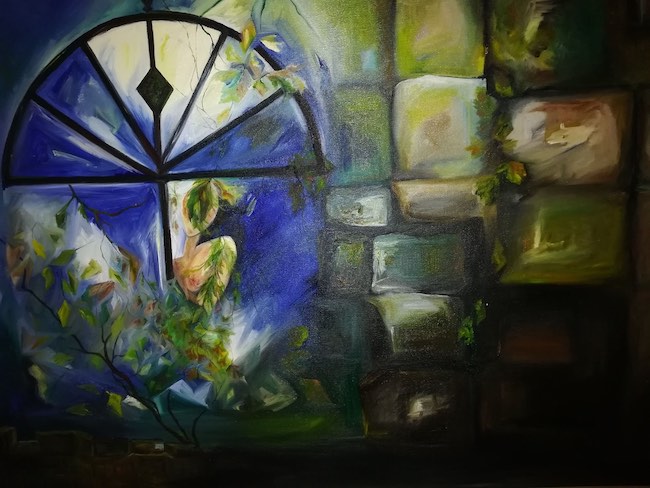La tendenza a raccontare tutto l’invisibile che inevitabilmente appartiene all’esistenza, dunque non solo dell’uomo ma anche della natura e dello spazio all’interno del quale la vita stessa si muove, appartiene a quel gruppo di artisti che si pongono in posizione di ascolto nei confronti di tutto ciò che spesso non viene notato, proprio in virtù di una particolare sensibilità e della capacità di interconnettere una riflessione più logica con un lato spirituale che non sempre, anzi in realtà quasi mai, sono completamente scollegati. Milena Manili ha compiuto questo tipo di percorso esplorativo della realtà, da un lato coltivando la sua natura artistica che l’ha condotta a sperimentare nuove tecniche e un’evoluzione del linguaggio creativo attraverso il quale rivelare la voce di quel sottobosco di energie silenziose che circondano la vita, dall’altro stimolando il suo lato più logico derivante dalla sua formazione filosofica in virtù della quale si è avvicinata alle tematiche umanistiche, generando dunque una sintesi ai suoi pensieri e alla sua visione delle cose attraverso l’espressione artistica.
Nel momento in cui l’arte ha deciso di smettere di essere puramente contemplativa e di cercare la riproduzione della realtà nella maniera più fedele possibile all’osservato, all’equilibrio estetico e alla perfezione rappresentativa, ha cominciato a emergere un’attenzione nei confronti del sentire, del compito interpretativo dell’autore di un’opera, concretizzata con l’emergere di alcuni movimenti pittorici che ebbero la forza di gettare le basi per tutte le rivoluzioni artistiche che contraddistinsero il periodo a cavallo tra l’Ottocento e il Novecento. Già nella prima metà del Diciannovesimo secolo l’Arte Romantica introdusse tutto un universo di sensazioni, di emozioni, che mai prima di quel momento avevano fatto parte di un’opera d’arte, lasciando che i grandi protagonisti di quello stile, in particolar modo quelli più intimisti come William Turner, John Constable e Caspar David Friedrich, imprimessero nelle tele tutto quell’universo emozionale grazie al quale si confrontavano con la natura impetuosa o rassicurante oppure portatrice di messaggi incomprensibili, decifrabili solo attraverso una spiccata apertura empatica. Questo tipo di approccio tanto predisposto all’ascolto condusse, qualche decennio dopo e oltre la pausa costituita dal Realismo in cui l’osservato doveva avere la priorità sul sentito, fu reinterpretato ed esteso a ulteriori esplorazioni spirituali dagli esponenti del Simbolismo, movimento che intendeva addentrarsi negli enigmi silenti, quelli nascosti sotto la superficie della realtà o quelli che mettevano in contrapposizione l’umano con il divino, con il soprannaturale, come se solo spingendosi verso la conoscenza di queste energie fosse possibile scoprire la vera essenza dell’essere umano, il senso della vita e anche della morte, le inquietudini, le angosce, tutte le sensazioni percepite quando la razionalità non è in grado di dare spiegazioni a ciò che va riconosciuto come esistente. Odilon Redon, più morbido e romantico nelle opere pittoriche ma decisamente più inquietante e irreale nei disegni, Arnold Böcklin che indagava e rifletteva sul mondo oltre la morte, e Gustave Moreau più legato a una simbologia classica, mitologica seppur sempre impregnata di elementi soprannaturali, furono tutti incredibili interpreti del movimento che si diffuse in tutta Europa.
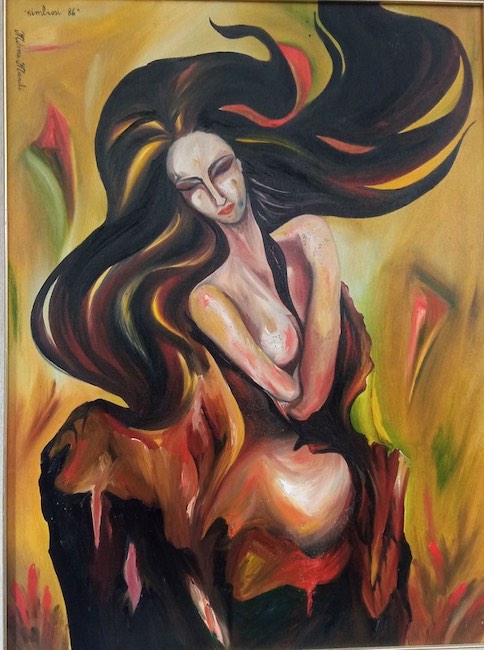
L’artista romana Milena Manili, da molti anni naturalizzata calabrese, si inserisce esattamente in questo contesto di esplorazione di energie, di rievocazioni, di interazioni tra ciò che è interno all’essere umano, al suo desiderio di apprendimento, e ciò che invece appartiene al mondo che egli abita, con tutta la sua vita segreta e sotterranea che in qualche modo va a influenzare e a modificare alcuni meccanismi di causa ed effetto appartenenti ai frammenti di esistenza di ciascuno. È dunque il Simbolismo lo stile scelto per effettuare un percorso di profonda conoscenza che da un lato è completamente guidato dall’istinto creativo che le permette di muoversi liberamente sulla tela senza dover sottostare ad alcuna regola stilistica che non sia quella suggerita o dettata dal suo istinto esecutivo, dall’altro invece non può non emergere la profonda riflessione, l’acuta analisi che la Manili compie nell’osservazione della realtà, delle evidenze che pur non essendo empiricamente tangibili esistono in qualche modo a livello percettivo e raggiungono la coscienza con la stessa forza di una qualsiasi esperienza concreta.
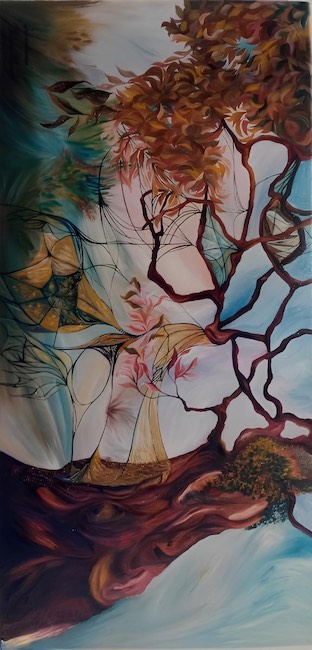
Il risultato visivo e tradotto in arte di questo tipo di approccio è un mondo sospeso tra realtà e fantasia, tra immagini apparentemente possibili che però vanno a confondersi all’interno di scenari improbabili, proprio perché ciò che Milena Manili punta a far emergere è quella parte irrazionale in grado di condurre verso l’inspiegabile, ciò che non essendo conoscibile dalla mente potrebbe rimanere in un angolo silenzioso della coscienza da cui potrebbe non essere capace di fuoriuscire. Attraverso l’ascolto sonoro della realtà intorno e quello visivo della creazione figurativa, l’artista spinge l’osservatore verso un livello più elevato, parallelo eppure in qualche modo in grado di permettergli di mettersi in discussione, di domandarsi quanto della realtà vissuta e di ciò che l’occhio è abituato a vedere, sia davvero tutto ciò che esiste oppure se una parte di quell’abitudine visiva, quella più sottile, venga invece trascurata e messa in silenzio dalla contingenza.
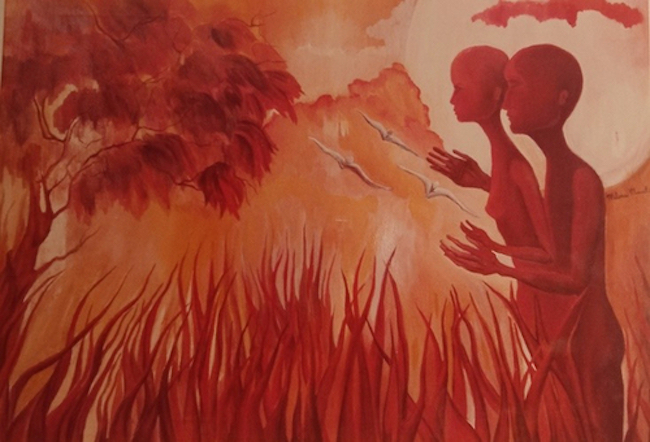
Il pensiero, la riflessione e l’analisi logica possono pertanto coesistere con l’irrazionalità, con il sentire, con l’intangibile eppure fortemente esistente a livello inconscio e così forte da governare scelte e strutture esistenziali solo attraverso la forza della percezione; questo è il messaggio di Milena Manili, tanto quanto il corso della sua esistenza è stato votato esattamente alla necessità di far convivere le sue due anime, quella razionale legata allo studio e all’insegnamento della filosofia e quella artistica.
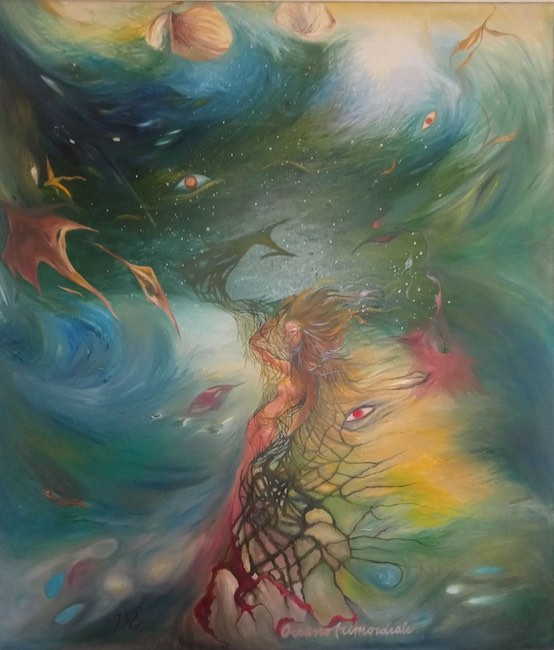
Nell’opera Oceano primordiale questa bivalenza è sottolineata dall’atmosfera quasi onirica in cui la donna sembra fluttuare, laddove però una parte è trattenuta con i piedi a terra da quella che sembrerebbe essere una radice, seppure parzialmente sommersa, metafora della concretezza del ragionamento e della logica, mentre l’altro lato tende verso l’evanescenza, il sogno, la spinta romantica a immaginarsi diversa, senza alcun tipo di condizionamento. In questa tela emerge un elemento tipicamente surrealista, quello degli occhi galleggianti nel cielo, simbolo di un desiderio di approfondimento, di conoscenza dell’ambiente che circonda la vita, di interazione con l’incanto che fuoriesce solo in alcune fasi, quelle di profonda connessione con la propria parte spirituale.
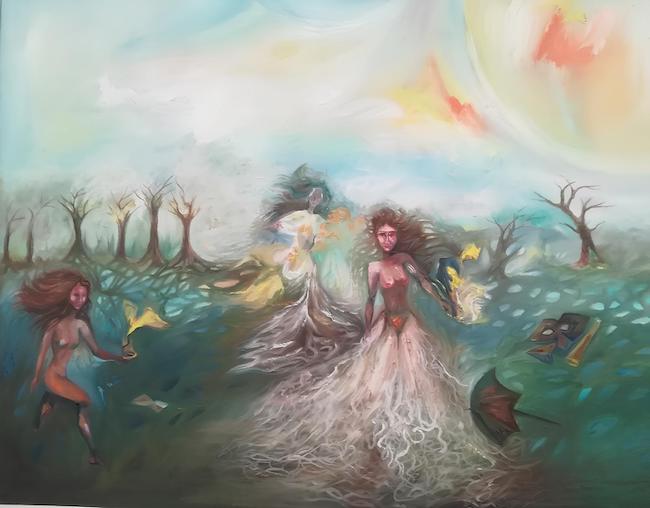
In Ballo di mezzanotte invece, contrariamente all’essenza del titolo che indicherebbe un paesaggio notturno, ciò che domina la tela è la luce, il chiarore del cielo come se esso volesse proteggere il movimento sottostante, le ragazze che sembrano essere in procinto di realizzare un rito magico a seguito del quale prendere una maggiore coscienza della propria essenza, della libertà che inevitabilmente appartiene all’individuo e della capacità di accettare e accogliere la propria natura. In qualche modo ciò che Milena Manili evidenzia è l’appartenenza dell’essere umano al mondo circostante, quell’incantata interrelazione con ogni elemento del cielo e della terra che si connettono con l’animo umano e vi entrano in dialogo quasi a esserne guide silenziose e al contempo emanazione.
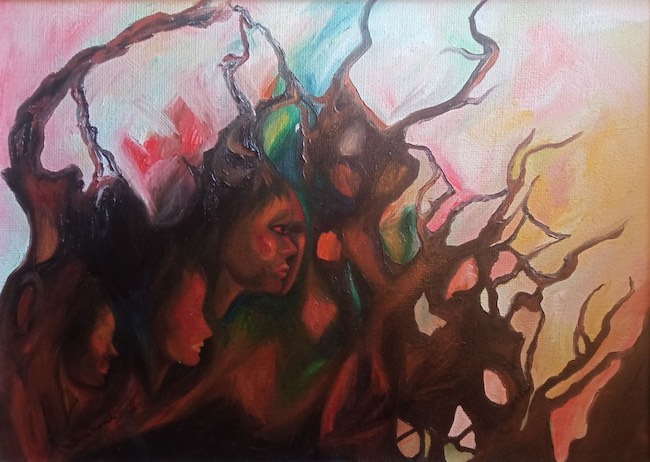
Il medesimo tema è affrontato ed estremizzato nelle opere della serie Simbiosi in cui tra uomo e natura non vi è più la distanza formale bensì una totale compenetrazione, l’uno è parte dell’altra e viceversa, come se non fosse possibile, raggiunto un più elevato livello di consapevolezza, separare due mondi che di fatto sono reciprocamente essenziali, perché se è vero che la natura dona e permette la vita dell’essere umano, lo è altrettanto che è attraverso il pensiero e la coscienza dell’uomo che la natura può far sentire in maniera più chiara il suo respiro, la sua presenza in un mondo troppo frequentemente dimentico di lei.
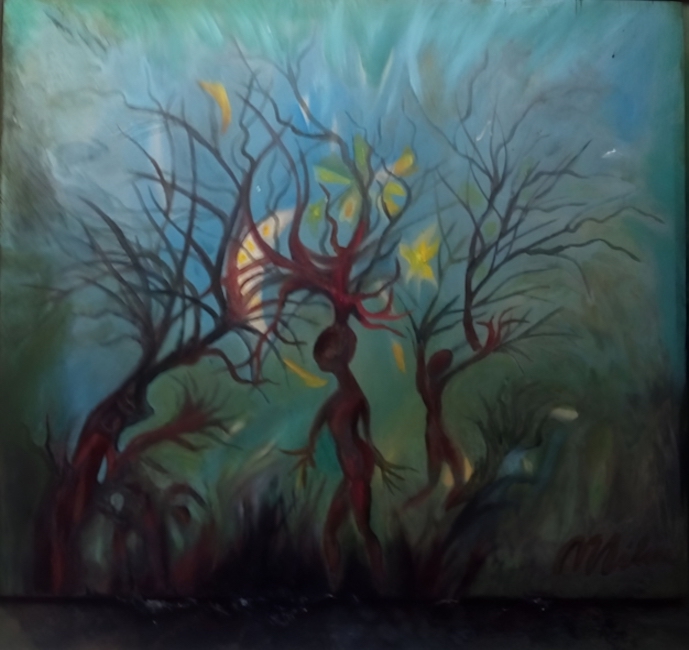
Ecco dunque che le chiome e le radici degli alberi sono estensioni della sostanza dell’essere umano, assumono funzione protettiva ma anche amplificatrice di quell’istintualità perduta a causa dell’eccessiva razionalità, di un pragmatismo necessario a sopravvivere nella società ma al contempo limitante per la coscienza individuale di ciascuno. Milena Manili ha alle spalle un lunghissimo cammino artistico, iniziato fin da giovanissima e affiancato al suo amore per lo studio della filosofia; nel corso degli anni ha istituito in Calabria percorsi di recupero motivazionale per ragazzi disagiati attraverso l’espressione artistica, sottolineando quanto l’arte possa colmare le fragilità emotive dei giovani e costituire un modo per canalizzare in maniera positiva sensazioni altrimenti destabilizzanti. Il suo percorso sociale si affianca a quello delle esposizioni artistiche delle sue opere che l’hanno portata nel corso degli anni a ricevere premi e riconoscimenti.
MILENA MANILI-CONTATTI
Email: manilimilena@gmail.com
Facebook: www.facebook.com/milena.manili.1
Instagram: www.instagram.com/milena_manili/
Linkedin: www.linkedin.com/in/milena-manili-79882645/
Symbolism as research into the interaction between energies and the human soul in the enchanted atmospheres of Milena Manili
The tendency to recount all the invisible that inevitably belongs to existence, therefore not only of man but also of nature and of the space within which life itself moves, belongs to that group of artists who place themselves in a position of listening to all that is often unnoticed, precisely because of a particular sensitivity and the ability to interconnect a more logical reflection with a spiritual side that is not always, indeed almost never, completely disconnected. Milena Manili has pursued this type of path of exploration of reality, on the one hand by cultivating her artistic nature, that has led her to experiment with new techniques and an evolution of creative language through which to reveal the voice of that undergrowth of silent energies that surround life, and on the other hand by stimulating her more logical side deriving from her philosophical training, by virtue of which she has approached humanistic themes, thus generating a synthesis to her thoughts and her vision of things through artistic expression.
At a time when art decided to stop being purely contemplative and to seek the reproduction of reality as faithfully as possible to the observed, to aesthetic balance and representational perfection, began to emerge an attention to feeling, to the interpretive task of the author of an artwork, concretised with the emergence of certain pictorial movements that had the power to lay the foundations for all the artistic revolutions that characterised the period between the 19th and 20th centuries. Already in the first half of the 19th century, Romantic Art introduced a whole universe of sensations, of emotions, that had never before been part of a work of art, leaving the great protagonists of that style, especially the more intimist ones such as William Turner, John Constable and Caspar David Friedrich, imprinted on their canvases all that emotional universe thanks to which they confronted the impetuous or reassuring nature or the bearer of incomprehensible messages, decipherable only through a marked empathic openness. This type of approach so predisposed to listening led, a few decades after and beyond the break constituted by Realism in which the observed was to take priority over the felt, was reinterpreted and extended to further spiritual explorations by the exponents of Symbolism, a movement that intended to delve into the silent enigmas, those hidden beneath the surface of reality or those that pitted the human against the divine, with the supernatural, as if only by pushing towards the knowledge of these energies was it possible to discover the true essence of the human being, the meaning of life and also of death, the anxieties, the anguishes, all the sensations perceived when rationality is unable to give explanations to what must be recognised as existing. Odilon Redon, softer and more romantic in his paintings but decidedly more disturbing and unreal in his drawings, Arnold Böcklin, who investigated and reflected on the world beyond death, and Gustave Moreau, who was more tied to a classical, mythological symbolism, albeit always imbued with supernatural elements, were all incredible interpreters of the movement that spread throughout Europe. The Roman artist Milena Manili, who has been naturalised in Calabria for many years, fits precisely into this context of exploration of energies, of evocations, of interactions between what is internal to the human being, to his desire to learn, and what instead belongs to the world he inhabits, with all its secret and subterranean life that in some way goes to influence and modify certain cause and effect mechanisms belonging to the fragments of each person’s existence. Therefore, Symbolism is the style chosen to carry out a path of profound knowledge that, on the one hand, is completely guided by her creative instinct that allows her to move freely on the canvas without having to submit to any stylistic rules other than those suggested or dictated by her executive instinct. On the other hand, cannot fail to emerge the profound reflection and acute analysis that Manili carries out in her observation of reality, of the evidence that, although not empirically tangible, exists in some way at a perceptive level and reaches the conscience with the same force as any concrete experience. The visual result and translated into art of this type of approach is a world suspended between reality and fantasy, between apparently possible images that are, however, blurred within improbable scenarios, precisely because what Milena Manili aims to bring out is that irrational part capable of leading towards the inexplicable, that which, not being knowable by the mind, might remain in a silent corner of consciousness from which it might not be able to escape. By listening to the sound of the reality around her and the visual one of the figurative creation, the artist pushes the observer towards a higher level, one that is parallel and yet somehow able to allow him to question himself, to ask himself how much of the lived reality and what the eye is accustomed to seeing is really all that exists, or whether a part of that visual habit, the more subtle one, is instead neglected and silenced by contingency.
Thought, reflection and logical analysis can therefore coexist with irrationality, with feeling, with the intangible yet strongly existing at an unconscious level and so strong as to govern existential choices and structures only through the force of perception; this is Milena Manili‘s message, as much as the course of her existence has been devoted precisely to the need to bring together her two souls, the rational one linked to the study and teaching of philosophy and the artistic one. In the painting Oceano primordiale (Primordial Ocean), this bivalence is emphasised by the almost dreamlike atmosphere in which the woman seems to float, where one side is held with its feet to the ground by what would seem to be a root, albeit partially submerged, a metaphor for the concreteness of reasoning and logic, while the other side tends towards evanescence, the dream, the romantic urge to imagine itself as different, without any kind of conditioning. In this canvas, a typically surrealist element emerges, that of the eyes floating in the sky, a symbol of a desire for deepening, for knowledge of life’s surroundings, for interaction with the enchantment that only emerges in certain phases, those of profound connection with one’s spiritual side. In Ballo di mezzanotte (Midnight Dance), on the other hand, contrary to the essence of the title which would indicate a nocturnal landscape, what dominates the canvas is the light, the glow of the sky as if it wanted to protect the movement underneath, the girls who seem to be about to perform a magical rite as a result of which they become more aware of their own essence, of the freedom that inevitably belongs to the individual and the ability to accept and embrace one’s own nature. Somehow what Milena Manili highlights is the belonging of the human being to the surrounding world, that enchanted interrelation with every element of the sky and earth that connect with the human soul and enter into dialogue with it almost as if they were its silent guides and emanation at the same time.
The same theme is addressed and taken to extremes in the artworks of the Symbiosis series in which there is no longer a formal distance between man and nature but a total interpenetration, one is part of the other and vice versa, as if it were not possible, having reached a higher level of awareness to separate two worlds that are in fact mutually essential, because if it is true that nature bestows and enables human life, it is equally true that it is through human thought and consciousness that nature can make its breath felt more clearly, its presence felt in a world all too often oblivious of her. Here, then, the foliage and roots of trees are extensions of the substance of the human being, they take on a protective function but also amplify that instinctuality lost due to excessive rationality, a pragmatism necessary to survive in society but at the same time limiting to the individual conscience of each one. Milena Manili has a very long artistic career behind her, which she began at a very young age and which goes hand in hand with her love for the study of philosophy. Over the years, she has set up motivational rehabilitation courses in Calabria for disadvantaged young people through artistic expression, emphasising how art can bridge the emotional fragility of young people and constitute a way of channelling otherwise destabilising feelings in a positive manner. Her social path stands alongside the artistic exhibitions of her artworks that have led her to receive awards and recognition over the years.


